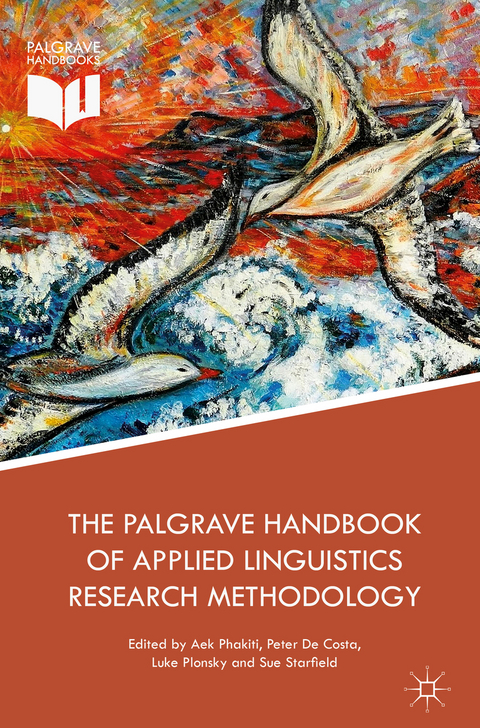
The Palgrave Handbook of Applied Linguistics Research Methodology
Palgrave Macmillan (Verlag)
978-1-137-59899-8 (ISBN)
Aek Phakiti is an associate professor in TESOL at The University of Sydney, Australia. Peter De Costa is an assistant professor in the Department of Linguistics and Languages at Michigan State University, USA. Luke Plonsky is an associate professor of Applied Linguistics at Northern Arizona University, USA. Sue Starfield is a professor in the School of Education at The University of New South Wales, Australia.
Part I: Research Approaches and Methodology.- Chapter 1: Applied Linguistics Research: Current issues, methods and trends; Aek Phakiti, Peter De Costa, Luke Plonsky and Sue Starfield.- Chapter 2: Habits of Mind: How Do We Know What We Know?; Richard Young.- Chapter 3: Quantitative Methodology; Luke Fryer, Jenifer Larson-Hall, and Jeffrey Stewart.- Chapter 4: Qualitative Methodology; Shim Lew, Anna Her Yang and Linda Harklau.- Chapter 5: Mixed Methodology; Alison Mackey and Lara Bryfonski.- Chapter 6: Literature Review and Research Synthesis; Shaofeng Li and Hong Wang.- Chapter 7: Research Replication; Rebekha Abbuhl.- Chapter 8: Ethical Applied Linguistics Research; Scott Sterling and Peter De Costa.- Chapter 9: Writing a Research Proposal; Sue Starfield.- Chapter 10: Writing a Research Article; Betty Samraj.- Part II: Research methods and data collection techniques.- Chapter 11: Interviews and Focus Groups; Matthew Prior.- Chapter 12: Observation and Fieldnotes; Fiona Copland.- Chapter 13: Online Questionnaires; Jean-Marc Dewaele.- Chapter 14: Psycholinguistics Methods; Sarah Grey and Kaitlyn M. Tagarelli.- Chapter 15: SLA Elicitation Tasks; Susan Gass.- Chapter 16: Introspective Verbal Reports: Think-alouds and Stimulated Recall; Melissa Bowles.- Chapter 17: Corpus Research Methods for Language Teaching and Learning; Magali Paquot.- Chapter 18: Digital Discourses Research and Methods; Christoph A. Hafner.- Part III: Data Analysis.- Chapter 19: Analysis of Association; Reza Norouzian and Luke Plonsky.- Chapter 20: Exploratory Factor Analysis; Aek Phakiti.- Chapter 21: Confirmatory Factor Analysis and Structural Equation Modeling; Aek Phakiti.- Chapter 22: Analysis of Group Differences; Luke Wander Amoroso.- Chapter 23: Statistics for Distribution-free Data; Jesse Egbert and Geoffrey T. LaFlair.- Chapter 24: Reliability Analysis; Kirby Grabowski and Saerhim Oh.- Chapter 25: Analysis of Spoken and Written Discourse; Scott Crossley and Kristopher Kyle.- Chapter 26: Narrative Analysis; Phil Benson.- Chapter 27: Interactional Analysis; Elizabeth Miller.- Chapter 28: Multimodal Analysis; Jesse Pirini, Tui Matelau and Sigrid Norris.- Part IV: Selected Research Topics and Areas in Applied Linguistics.- Chapter 29: Instructed Second Language Acquisition; Shawn Loewen.- Chapter 30: Bilingualism and Multilingualism; Tej Bhatia.- Chapter 31: Forensic Linguistics; Samuel Larner.- Chapter 32: World Englishes; Peter De Costa, Jeffery Maloney and Dustin Crowther.- Chapter 33: Heritage, Community, and Indigenous Languages; Shereen Bhalla and Terrence Wiley.- Chapter 34: Translation and Interpreting; Claudia Angelelli.- Chapter 35: Identity; Ron Darvin.- Chapter 36: Gestures; Gale Stam and Kimberly Buescher.- Chapter 37: Language Planning and Policy; David Johnson and Crissa Stephens.- Chapter 38: Second Language Pragmatics; Soo Jung Youn.- Chapter 39: Language Testing and Assessment; April Ginther and Kyle McIntosh.- Chapter 40: Linguistic Landscape; David Malinowksi.- Chapter 41: Academic Literacies; David Bloome, Gilcinei Carvalho and Sanghee Ryu.
| Erscheinungsdatum | 02.07.2018 |
|---|---|
| Zusatzinfo | 3 Illustrations, color; 103 Illustrations, black and white; XXXII, 926 p. 106 illus., 3 illus. in color. |
| Verlagsort | Basingstoke |
| Sprache | englisch |
| Maße | 155 x 235 mm |
| Themenwelt | Schulbuch / Wörterbuch ► Wörterbuch / Fremdsprachen |
| Geisteswissenschaften ► Sprach- / Literaturwissenschaft ► Sprachwissenschaft | |
| Sozialwissenschaften ► Soziologie ► Empirische Sozialforschung | |
| Schlagworte | Applied Linguistics • Case Study Research • corpus research for language learning • Data Analysis • digital discourses • Ethical research practices • Ethnographic Research • methodological reform • Methodology • Mixed Methods Research • Multilingualism • narrative inquiry • Pragmatics • psycholinguistics methods • Qualitative research • quantitative research • research instruments • Semiotics • Transdisciplinarity |
| ISBN-10 | 1-137-59899-9 / 1137598999 |
| ISBN-13 | 978-1-137-59899-8 / 9781137598998 |
| Zustand | Neuware |
| Haben Sie eine Frage zum Produkt? |
aus dem Bereich


